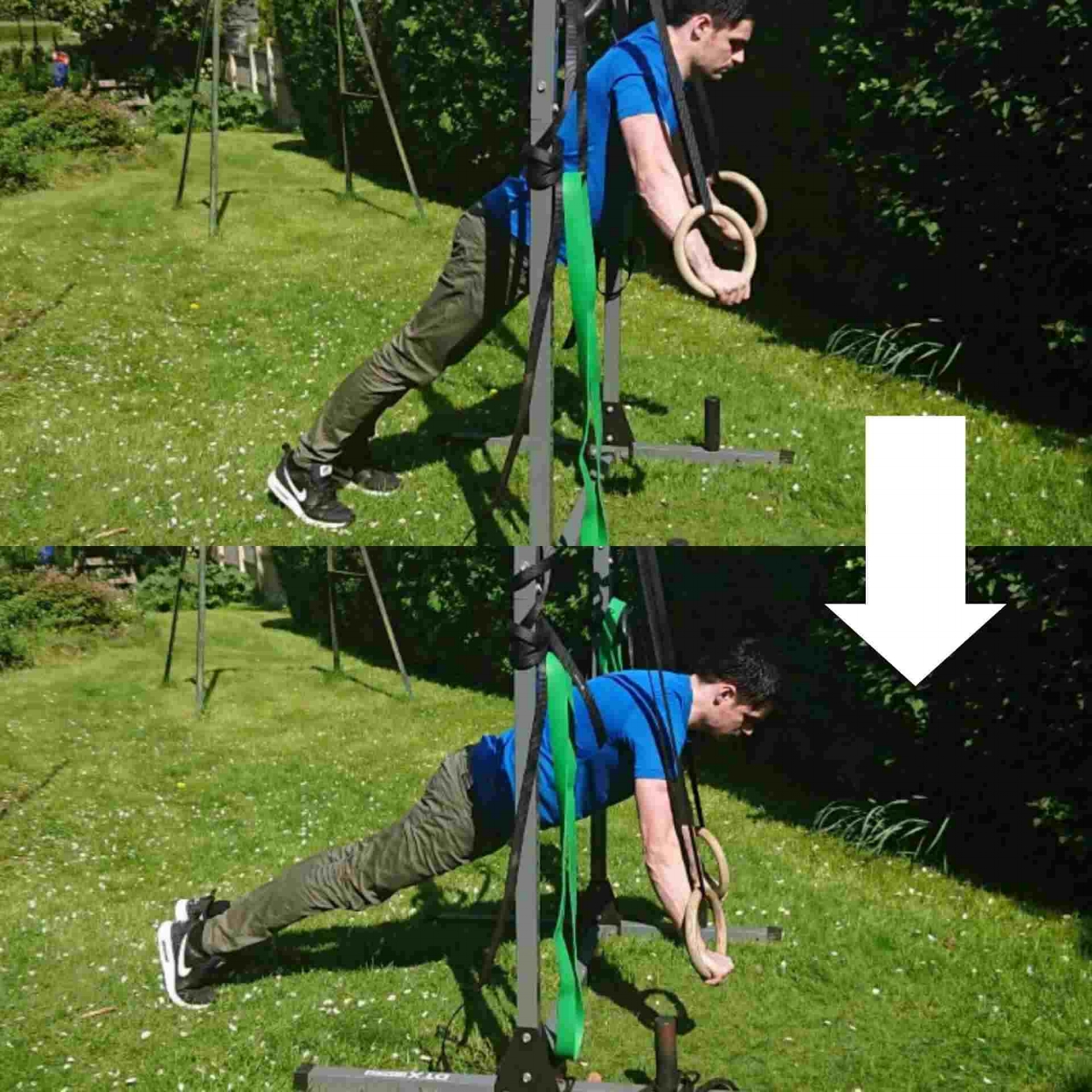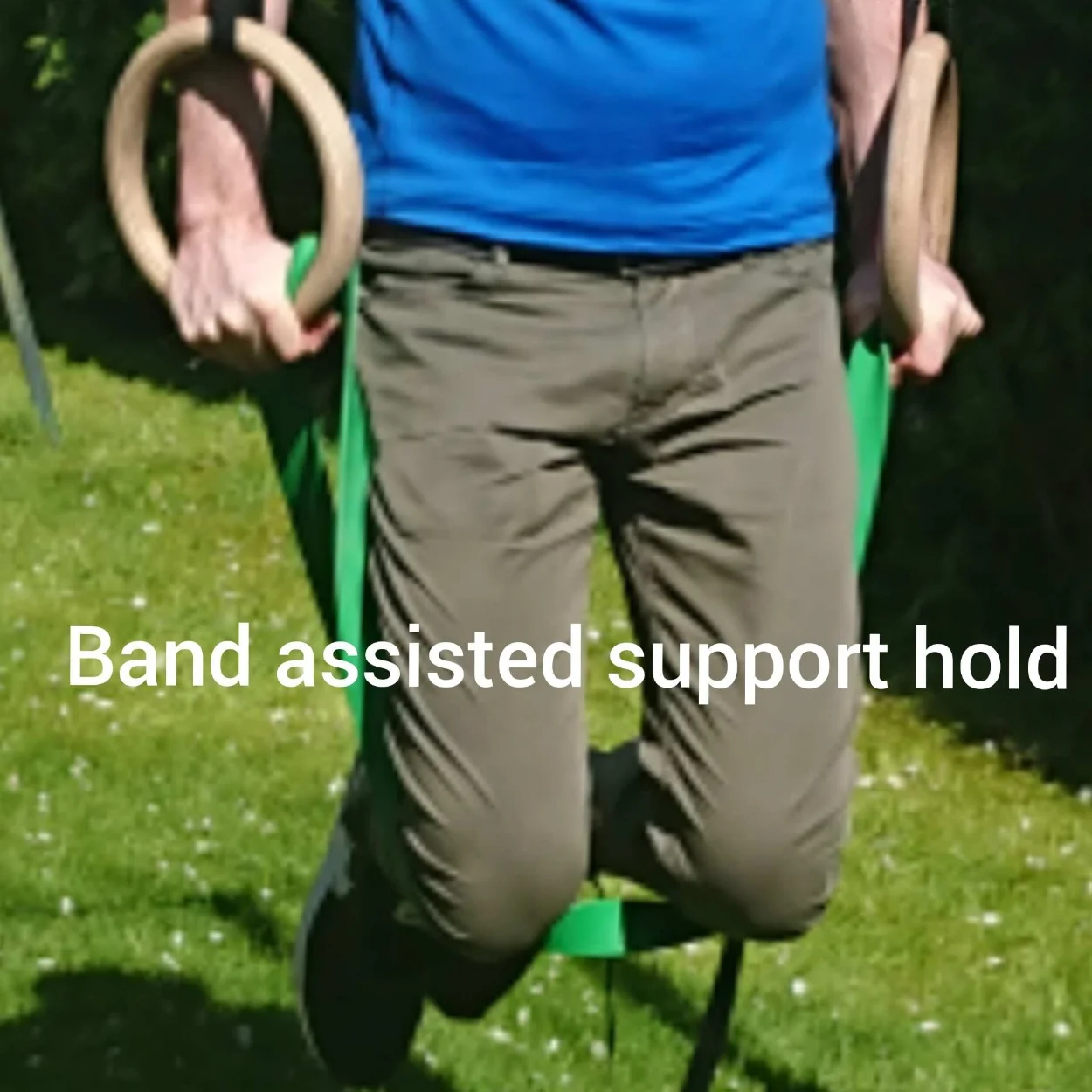Gymnastic Rings Support Hold: (Everything you Need to Know)
The top hold position or support hold is one of the fundamental gymnastic rings movements. The support hold is essentially an isometric exercise that requires strong shoulders, good balance, core strength and an ability to control and coordinate gymnastic rings.
The instability of rings is the main challenge when it comes to this exercise, but once you learn how to adapt to this new stimulus it opens up the possibility for many more calisthenics and gymnastics exercises, as well as improving body stability, resistance to injury and proprioception.
In this article we will look at in more detail:
What is the top hold or support position?
Why is support hold so difficult?
What are the benefits of developing a strong support hold?
How can I train for it?
What is the top hold or support position?
The support hold is a static hold with gymnastic rings where your arms are locked out straight and you are supporting your body weight above the rings as shown.
This is one of the fundamental positions in gymnastics rings and calisthenics training.
The support hold requires good balance and stability, strong shoulders, coordination and core strength. The support position on rings is an isometric exercise within its own right and it is far more difficult then the equivalent hold on parallel bars or a dip station.
It is a great base from which to develop your gymnastics training and it is essential to have a good strong support hold in order to be able to master techniques such as:
Dips
l-sits
Muscle ups
planche
Or any other technique that requires you to be above the rings.
Why is it so difficult?
Techniques or positions where you are supporting your body weight above the rings are more difficult then where you hold your weight below the rings.
So for example a dip on the rings is more difficult then a pull up, or holding top position on the rings is harder then holding onto the rings in a dead hang.
This is primarily due to one factor:
Instability
Gymnastic rings can move independently from one another, rotate and move in any direction, depending on the force is being applied to them. This is in contrast to a pull up bar which remains static as it is fixed to the ground rather then being suspended.
The instability element means that you have to control and balance the rings as well as perform the technique or hold position.
This means exercises on rings require more muscle engagement then the equivalent exercises performed on a pull up bar/parallel bar.
Instability is felt more when you are in hold, or above the rings because the stabilising muscles of the shoulder have to work hard to support the body and stay balanced.
When you are holding with your body weight beneath the rings in a pull up dead hang, your grip is engaged but your shoulders aren't supporting your body weight in the same way and the body is more passively hanging rather then fighting for the same balance in the support position.
It is predominately the four muscles of the rotator cuff (Supraspinatus, Infraspinatus, Teres minor, and Subscapularis) and their corresponding tendons that are responsible for stabilising the shoulder joint.
The shoulder muscles capacity for stability is rarely tested, therefore, there is often a strength imbalance between the primary movers for pushing exercises (the chest, triceps and shoulders) and the stabilising muscles of the shoulder.
A lot of the conventional shoulder exercises target the shoulder for aesthetic purposes by isolating certain muscles and thereby removing any stability component.
For example, smith machine bench press, chest press and lateral raises all work muscles such as the deltoid, trapezius, triceps and pectoral but do not put any real emphasis on the stabilising muscles as the exercise machine equipment is already stable and set to a predetermined plane of motion.
Its is because of this strength imbalance, between primary movers and stabilising muscles, that pushing strength developed from other exercises, tend not to translate very well to pushes or holds with gymnastic rings.
So if you can do 10 reps of dips on parallel bars and then try to do the same on gymnastic rings, its likely that you will not be able to hold yourself in a support position let alone achieve a single rep.
You need to adapt to the new stimulus of instability, by mastering the support hold.
What are the benefits of developing the top hold position?
Stronger more injury resistant shoulders
Starting point for other, more advanced support exercises, such as the dip, l-sit and muscle up
It will help you develop greater strength, stability, coordination and proprioception
Improves your bench press personal records
The main benefit to developing a strong top hold position is the strength gained in the muscles of the rotator cuff. The shoulder has ball and socket joint. This allows the arms its great range of motion and its ability to rotate 360 degrees.
The rotator cuffs primary purpose is to keep the joint stable and coordinated. A strong rotator cuff helps prevent shoulder injuries, tears and dislocations.
A more stable shoulder is advantageous for other exercises such as bench press. Your chest can be strong but your stabilising muscles can be comparatively weaker. This will hold back your potential when bench pressing and also increase the risk of injury.
Developing a strong top hold on gymnastic rings will directly address the strength imbalance between stabilising muscles and your chest/triceps.
The body's adaptive response to the instability of the rings is to strengthen all the supporting muscles of the shoulder joint as well as your chest and core.
If the joint is stronger then you will be able to support a heavier weight safer and potentially break through your bench press plateaus.
Top hold position is also the starting point for many rings exercises such as the dip and muscle up or any other movement that requires support.
Gymnastic rings are the most versatile training tool with tons of benefits to unlock your full athletic potential.
If you want to know how to do these exercise check out my dip tutorial and full muscle up tutorial.
How can I Train for Support Hold?
To train for the support hold and perhaps ultimately to progress to the dip we need address the strength imbalance between your shoulder stabilising muscles and the rest of the body.
The best place to start is:
Static ring holds with your feet on the ground and...
Band assisted, partial body weight support holds
In order to condition the shoulder and the other muscles required for the support position we need to expose the body to the stimulus of instability in a tolerable way without overwhelming the muscles.
This is done by replicating the top hold but with your feet on the ground, like you are about to do a press up. The great thing about gymnastic rings is that the height of the rings is easily adjustable. Therefore the intensity of the exercise can be adjusted by lowering the height of the rings.
This allows you to gradually increase the difficulty as your shoulders become stronger and more able to cope with the instability.
The lower the height of the rings, the more difficult the hold becomes
Lower the rings to a position where you can comfortably hold onto the rings as in the photo. I'd recommend trying and angle of about 45 degrees to begin with.
This position is similar to a plank that you'd do on the floor, but with an instability element so the difficulty level is already significant so don't be overly ambitious at this point and try a lower, more difficult angle off the bat.
If you can tolerate this position at 45 degrees for 30 seconds even if you are a little shaky then you are doing well.
If you are at the point where you can do this comfortably, then by all means lower the rings at try again at a difficult angle for 30 seconds
The goal here is to get the rings close to the floor and your body at a low angle.
Remember to keep your arms locked out straight as this replicates the same position as a support hold.
Also remember we are both acquiring a technique and building strength here so do not over train.
Just do this as a drill perhaps at the end of your regular workout twice a week and do 3 sets of the 30 seconds isometric hold at an angle that you are comfortable with.
There is no need to do it anymore then that as this can be a taxing exercise on your core, arms and shoulder muscles and incidentally can be a great exercise for developing abs for a six pack.
Once you are comfortable with these isometric drills in the push up position it is time to progress to the next exercise...
Top hold position with band support
This is another great training exercise to develop the a full unsupported support hold position on the rings.
Again, this exercise is scalable to meet different abilities and to progress safely.
For this you need a resistance band to assist you. If you have a range of bands then this is perfect.
Choose the thickest band with the most resistance, hold it in each hand and then grip the rings.
Place one knee on to the band and let it support you as you move into the support hold, then when your stable, place the other knee on the band.
This will assist you as you get accustomed to the support position with partial body weight.
If you have followed the previous steps faithfully you will have accrued a lot of strength and shoulder stability and may find this easy with a thicker band.
As you get more accustomed to the position then use a lighter band that is in line with your progression.
I recommend if you can hold the top position with a band for more then 30 seconds then it is time to advance to either a lighter band or try a full unassisted support hold.
Once you start to develop strength in your rotator cuff and any strength imbalance begins to equalise, progressing to a full top hold position for 30 seconds can be quite quick.
If you can hold a top position for 30 seconds then you will not only be able to move on to more techniques but your shoulder joint will be far more stable.
If you have mastered the top hold then the next rings technique you should try is the ring dip or perhaps discover the benefits of rings push ups...
And then eventually the holy grail of calisthenics rings training, the muscle up.
If you have any more questions about the top hold position then please leave a comment below and if this article helped you achieve your first solid support hold please give the article a share on social media using the icons below ↓↓↓





